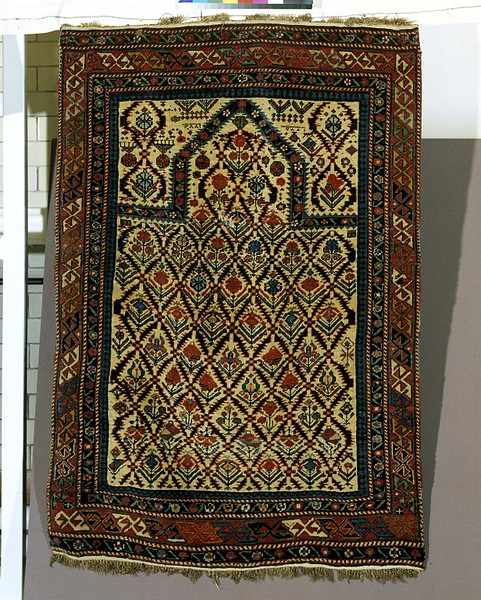|
Place of origin: Azerbaijan (made)
Date: 1800-1876 (made)
Artist/Maker: unknown
Materials and Techniques: Hand knotted woollen pile, on woollen warp and
cotton weft; symmetrical knots, with some double knotting and some vertical
lines of asymmetrical knotting, possibly to rectify the shape of the
weaving; 94 knots per sq. in (1,428 per sq. dm)
Museum number: 358-1878
Gallery location: In store
Public access description
Small carpets with a single arch or niche in the design are often referred
to as 'prayer carpets'. Carpets or embroidered cloths [which are
easier to carry around] are often used to define a person's space during
Muslim prayer rituals. The arch is usually understood to represent the
mihrab or decorative panel in the wall of a mosque which indicates the
direction of Mecca.
Physical description
Carpet, Prayer Carpet, hand knotted woollen pile on woollen warp and
cotton weft, Caucasian, 19th century
WARP: cream and brown wool plied 2 cream plus 1 brown; Z3S; 17 threads per
inch (68 per dm). NB: extra warp threads have been
introduced in the lower, outer border 12 times.
WEFT: white cotton; Z2S; 2, sometimes 3 or 4 shoots after each row of knots;
the number of rows of knots varies with an average of 11 per
inch (42 per dm).
PILE: wool; 9 colours: dark red, red, dark yellow, green, dark blue, blue,
dark brown, light brown, cream; symmetrical knots (NB some double
knotting, eg towards the top of the niche; some vertical lines of apparently
asymmetrical knotting, eg in the lower left field. Both variations may
be to rectify the shape of the weaving); the knots tied around 2 threads; 94
knots per sq. inch (1428 per sq. dm).
SIDE FINISH: both sides missing.
END FINISH: lower: incomplete; 3/8" (1 cm) plain weave with white cotton,
then 2" (5 cms) max of knotted fringe tied in groups of 5 warp
threads. Upper: incomplete; as above but only 12" (4 cms) of fringe.
DESIGN: field: cream ground with jagged, dark blue lattice with yellow-centred
crosses at each junction and framing eight offset bands of five
or six varied floral sprigs with six further sprigs within the niche. Each
spandrel contains two sprigs within their lattice and other floral and
geometric motifs, including a pseudo date. The niche is outlined by an
angular, dark blue band bearing small flowers separated by a
single-angle green line.
Main border: red ground with multi-coloured, angular and barred S motifs,
their forked terminals ending in triangles. At the two lower corners
there is a dark blue square bearing a white cross.
Inner border: this is as the outline band of the niche.
Innermost border: reciprocal diamond-headed design in dark brown and blue
with a modified version in the lower border.
Catalogue Date: 29.3.95
Museum number: 358-1878
URL: http://collections.vam.ac.uk/item/O67288/carpet/
 |

